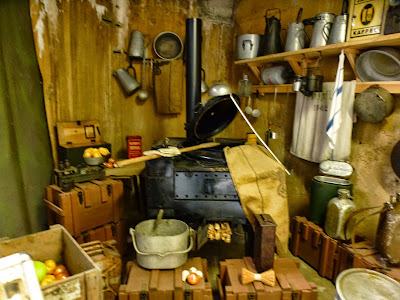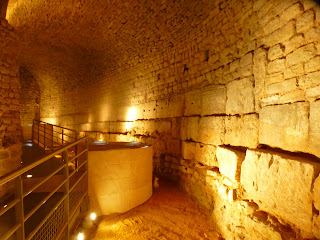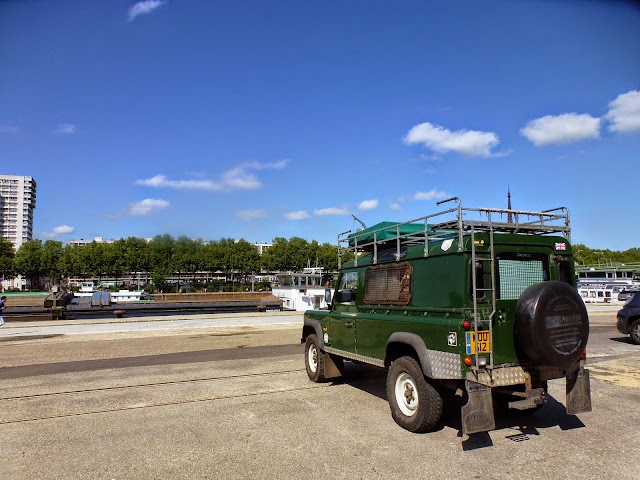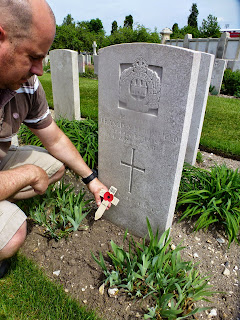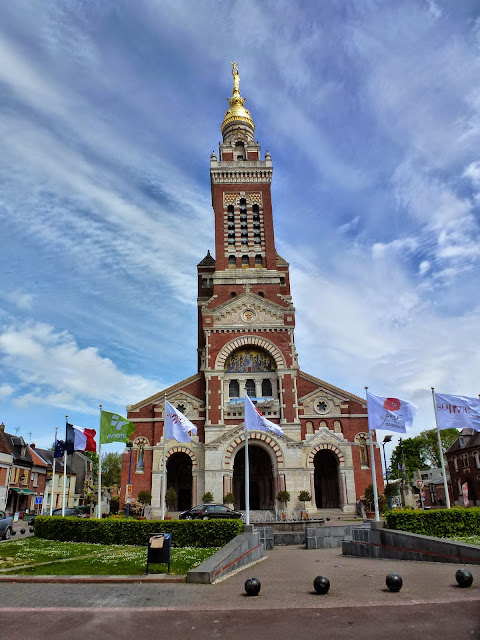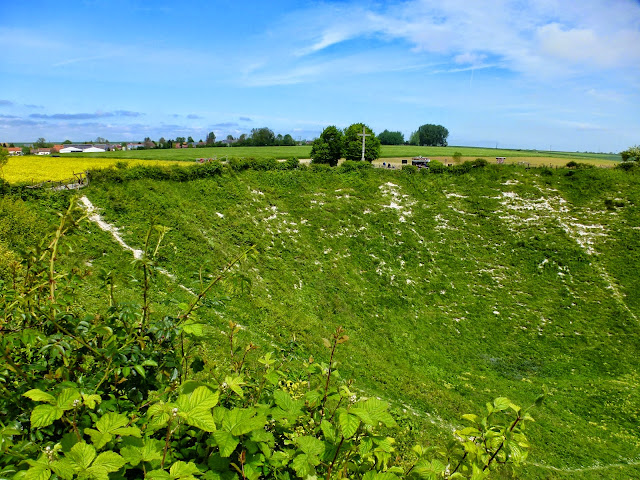My trip to northwest France was mainly to visit the grave of my mothers second uncle who died on the Somme on 8 May 1915 - exactly one hundred years ago. I also wanted to visit some significant First and Second World War sites.
I left Dover by DFDS ferry and arrived in Calais as planned. Switch on the new satnav! I headed west and drove to Cap Blanc Nez. This is a prominent chalk headland overlooking the channel towards the south coast of the England. A bit too hazy to see England while I was there...
The headland was occupied by the Germans during WW2 as a prime spot to monitor movements in the channel and to blast away at anything that moved on the sea or in the air. It's still dotted with the remains of bunkers and gun emplacements.
In the months leading up to the D-Day, the allies had devised a vast and extremely complex deception plan called Operation Fortitude which convinced Hitler and his Generals that the invasion would happen near Calais. The essence of deception then and now is to build on what the enemy already thinks and, by dropping careful hints, convince him that his suspicions are right when all along you have other plans. Of course the 1944 invasion actually took place on the Normandy coast many miles to the south and even while it was underway in the early morning of 6 June, Hitler still thought that Calais was the intended target. Many of his Generals were so afraid of the man himself that they didn't want to inform him or argue with him until he convinced himself of the actual invasion location. In fact he remained asleep for the early stages of the landing and no one dared wake him - mad or what!
Just along the coast is Gris Nez used by the Germans for the same purpose.
You have to use your imagination a bit to see what it might have looked like with barbed wire, camouflage netting, guns, German solders etc but it must have looked pretty intimidating to the locals and anyone planning to attack from the sea.
Incidentally, you would think that most French people would have visited these places many times before but it seemed that most of them had chosen to visit on the day I was there. Do they all have Friday afternoon off?
Further down the coast I visited the Todt Battery Museum at Audinghen. This is a massive reinforced concrete gun emplacement that would have contained a cannon capable of easily reaching the south coast on England. During its operation it was surrounded by newly planted trees to help hide it and a domestic house was painted on the side to deter allied bombing. I can't imagine the allies would have been taken in by that.
It still shows the scars of war...
Inside, as you walk around various tunnels and chambers towards the place where the cannon stood, there are many exhibits of uniforms, guns, tools, materials, etc giving a good impression of what life was like working there during the war.
The cannon was vast and weighed over 100 tons and obviously pointed out to sea. It's hard to get the scale of this but the green fence at the front is about 7 feet high.
Alongside the concrete gun emplacement is one of the remaining gun carriages that was moved on rails around the countryside.
While it has been well restored, it still shows the dents from incoming bullets and shells while it was in active service...
My first over-night stop was at Boulogne-Sur-Mer next to the large medieval castle, containing a well preserved keep (bottom right hand corner of the map) and a complete curtain wall with four gate houses. Within the walls lie the old town buildings including shops, houses, hotels, restaurants, the impressive cathedral and official buildings. My spot for the night was next to the castle keep (blue arrow).
My view from the gallery window of Chateau Land Rover was quite nice...
A walk across the old town took about 5 minutes and a complete circuit of the walls, 20 minutes.
There was no explanation why the east gate wasn't just called 'The East Gate'. Perhaps it was taken from a scene in Up Pompeii. You can just imagine Lurcio saying, 'Oh no, don't titter Mrs, any port in a storm!'
Anyway, next morning I went into the museum in the old castle. It was well laid out, nicely presented and, as it was set within a fantastic building, it oozed historic character. The circular walls and the courtyard reminded me a bit of Colditz.
The museum is strung out on 3 floors and in the basement where its original Roman foundations can be seen.
From Boulogne, I traveled further down the coast to Dieppe intending to visit the museum that explains the ill-fated raid during the second world war. The Military Top-Brass and leading Politicians, including Churchill, never really explained the real purpose of the raid but it was thought to act as a dry run for the D-Day landings. While it proved to be a complete and costly failure, afterwards it was said that important lessons were learnt and ultimately saved many lives on D-Day.
When I arrived in the town, I found much of the town centre cordoned off for a street fair and I couldn't get to where I wanted to go even with the satnavs help so I parked and walked around the fair.
Later, I settled down for the night. In the morning, I decided not to bother with the museum as, from the outside, it looked like it would be disappointing.
I drove to Rouen. With a bit of satnav-aided exploration, I found my way to the riverside where people were walking, rollerskating, jogging, biking or just sitting in the sun. This area had essentially been the town's riverside port on the banks of the Seine. All the warehouses and holding areas had been cleared away, leaving just a hint of its historic past including the old railway lines. Once the landscaping is complete, it will be a fantastic resource.
The city must have been severely bombed during the Second World War, like so many other places. As a result, much of the built up area is modern but the central link through the town centre contains many fascinating buildings ranging from the main cathedral...
...to beautiful 17th century buildings used as shops, restaurants and flats...
The town is famous as the place where Joan of Arc was tried and burnt at the stake. A striking modern building marks the location
(try to ignore the round-about!)...
I met my son Matt later in the afternoon and we went to St Sever cemetery to pay our respects to Francis Stephen Bloomfield.
Matt and I have now visited the two Bloomfield brothers who were lost in France 100 years ago.
After our time at the cemetery, we walked into the centre for a bite to eat and a good chat. The next morning, we parted company and I headed for the town of Albert, which was a British military base during WW1.
The Somme 1916 Museum, in the basement of the main church, is a 'must see' place for any trip around the Somme.
It's important to understand what the residents and temporary visitors put up with during the war. The next photo gives a good impression...
The museum follows one of the main underground bunkers 10m below the church, and is very atmospheric. I won't spoil any visit you may make by adding photos of the interior, so just a shot of the main entrance...
The Lochnagar Crater lies about 3 miles up the road at the small village of La Boisselle. It was created by the Sappers mining under no-mans land and was blown up just a few minutes before the first day of the Somme battle - 1 July 1916.

It, and many others like it, blasted great gaping holes in the German trenches. Unfortunately, the week-long heavy artillery barrage and these explosions along the front line did not weaken the German positions enough and, when the smoke cleared, the German infantry, snipers and machine gunners resurfaced from their deep underground bunkers and wiped out most of the attacking Tommies. The statistics along the whole front are hard to comprehend with nearly 60,000 men lost just on the first day; 20,000 were killed. Of the 3 million men fighting at the front, 1.2 million were lost during the battle from July to November.
This crater, which is owned by an Englishman, now leaves a depression of 91 metres in diameter and 21 deep. It's scale can really only be appreciated from the air or actually walking around it. This photo shows about half of it!
I went on to visit a number of monuments and memorials to the east of Albert and there are many of them, after all this was at the centre of the fighting during the war, moving only short distances back and forth, with the loss of many thousands of lives.
My next significant stop was at Peronne, in the town held by the Germans for much of the war but then largely destroyed when they were forced to leave. The fine entrance towers and various walls nearby are now all that remains of the old castle; the rest of the building is new and houses a very good museum.
My next 'must see' memorial was at Mametz Wood, a vast woodland set within a rolling landscape that cost the allies thousands of lives to take from the Germans. While much of the wood was taken, the eastern section remained in German hands and they refused to leave. Send for the Welsh!
Despite ferocious fighting in the face of well protected machine gun positions, the Welsh took the remaining part of the wood and a few years ago a new monument was erected to commemorate this remarkable achievement and terrible loss of life. The red Welsh Dragon stands in the position the Welsh found themselves in as they prepared to attack across a low, very open valley. It must have been terrifying. This location is quite remote and a bit off the beaten track but it well worth visiting. It's now a beautiful, peaceful place to reflect on the horror of this particular engagement and the war in general.
* In fact, he was not that big, he just drives big Canadian lorries.
The next significant 'must see' sight is the vast memorial at Thiepval. At 45m high, it is the largest British memorial in the world with over 72,000 names engraved in the stone pillars
It is supported by a very good visitor centre, large car park and very attractive grounds.
Do you know, it's a small world. Not only did I bump into the Big Canadian Lorry Driver again but also someone from my home village in Suffolk. I was starting to think I was being followed!
The Newfoundland Memorial at Beaumont-Hamel commemorates the significant role played by the men of Newfoundland on the first day of the Somme and during the following months. This site, contains a good visitor centre, restored trench systems and cemeteries, extends to about 30 acres, and lies on the spot were the whole regiment was trapped while being pinned down by ferocious machine gun fire. After half an hour on the first day of the battle only 68 men remained. They suffered one of the highest casualty rates on the 1st July.
The regiments mascot, a Caribou, is reflected in this life-sized bronze statue. Quite striking!
On my way back to Calais, I stopped at Le Blockhaus, just off the A26. This site lies in a wooded glade and was one of the most significant WW2 sites where slave labourers built a vast reinforced concrete factory to build and launch the infamous V1 and V2 rockets. The scale of the place is breath-taking. It measures 33 high (just the part seen above ground), 75 m long and 40m wide. It took 90,000 tons of concrete to build.
For a long while the allies didn't know it existed and when they discovered it, they still couldn't work out what it was used for. However, they knew it had to be destroyed so a massive bombing raid was carried out on 27 August 1943 and it was put out of action. The scars of the bombing are plain to see. A number of bombs scored direct hits, like the one below, but it was a 'tall boy' bomb that finally put it out of action. It landed about 30m away, drilled itself into the ground and, when it exploded on a delay fuse, it sent an earthquake through the ground to shake the factory to its foundations. The factory was considered unsafe and closed.
It stands as a gruesome monument to one of the most evil wars in human history and to the people who build the structure and died there.
Photos cannot do it justice. I suggest you go and see it - its only a few miles from Calais.
Speaking of Calais, an odd site to visit lies in the heart of the town. This little museum is located in a German communications bunker in a modern park. It traces the history of the Second World War as seen by the people of Calais.
It's comprehensive and quite interesting but is showing its age. The exhibits are largely original but are presented in an old fashioned almost 'DIY' style. When compared with modern museums and their 21st century interpretation and computers, it has a lot to live up to and struggles. I suggest you only visit it if you're waiting for your ferry on a wet Thursday afternoon.
Score: 4/10 could do better. Ouch...
So, back to the ferry and home.
I'm pleased to say the trip lived up to my expectations. The sites were fantastic, all the people I met enhanced the trip and I learnt a lot more by seeing the places where history was made. I also got a much better understanding of what so many men went through.
Visiting the grave of Francis Stephen was important to both me and Matt. There is no one alive now who knew Stephen. I certainly didn't know him but it's important to pay respect when you can.
They, and many thousands, may have been lost in France but they have not been forgotten.







